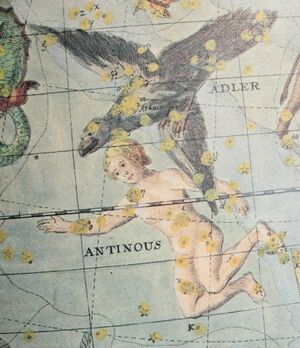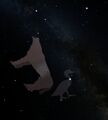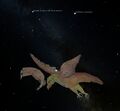Antinous: Difference between revisions
No edit summary |
|||
| Line 1: | Line 1: | ||
[[File:Adlerantinous web-1-474x275.jpg|alt=Antinous (Bode1781)|thumb|Antinous in Bode (1781)]]A "sub"-constellation (or asterism) Antinous was created by Ptolemy of Alexandria and published in the Almagest star catalogue 137 CE. It is placed in the constellation of [[Aquila]], The Eagle. |
[[File:Adlerantinous web-1-474x275.jpg|alt=Antinous (Bode1781)|thumb|Antinous in Bode (1781)]]A "sub"-constellation (or asterism) Antinous was created by Ptolemy of Alexandria and published in the Almagest star catalogue 137 CE. It is placed in the constellation of [[Aquila]], The Eagle. |
||
=== Greco-Babylonian Origin of the asterism name === |
|||
=== Name === |
|||
==== |
==== The Roman (hi)story behind it ==== |
||
[[wikipedia:Antinous|Antinous]] is the name of the boy lover of Emperor [[wikipedia:Hadrian|Hadrian of Rome]]. When Hadrian was in Egypt, Antinous drowned in the Nile. It was unclear from the outset whether this was an accident, suicide or murder. Of course, it can no longer be clarified today. The fact is that he fell into the water, could not swim and drowned. The grief-stricken emperor then declared a state of mourning in the Roman Empire and a cult of veneration began: Hadrian had a temple built for Antinous in the city of Rome, Antinous games were held in Athens and the astronomer Ptolemy of Alexandria placed the name of the deceased among the stars by inventing a new constellation. |
[[wikipedia:Antinous|Antinous]] is the name of the boy lover of Emperor [[wikipedia:Hadrian|Hadrian of Rome]]. When Hadrian was in Egypt, Antinous drowned in the Nile. It was unclear from the outset whether this was an accident, suicide or murder. Of course, it can no longer be clarified today. The fact is that he fell into the water, could not swim and drowned. The grief-stricken emperor then declared a state of mourning in the Roman Empire and a cult of veneration began: Hadrian had a temple built for Antinous in the city of Rome, Antinous games were held in Athens and the astronomer Ptolemy of Alexandria placed the name of the deceased among the stars by inventing a new constellation. |
||
In the sky, Antinous was now part of the constellation of the Eagle, and in the ''Almagest'' the stars are listed as a separate group in this constellation. |
In the sky, Antinous was now part of the constellation of the Eagle, and in the ''Almagest'' the stars are listed as a separate group in this constellation. |
||
| ⚫ | |||
| ⚫ | Interestingly, the eagle is one of the "Greek" constellations that are taken directly from Babylonian uranography. The Babylonians also had a bird of prey, an eagle (or a vulture), in exactly the same place in the sky. Next to the Babylonian constellation Eagle is the Babylonian constellation The Corpse. Since the Almagest contains many Babylonian reminiscences (e.g. Babylonian eclipse observations are quoted), it could be that Ptolemy's new creation refers to the older Babylonian constellation and merely changes its name. |
||
| ⚫ | |||
| ⚫ | |||
| ⚫ | |||
| ⚫ | |||
| ⚫ | |||
| ⚫ | In the '''Hathor temple in Dendera (Egypt)''', there are two zodiakoi: a rectangular zodiac in the pronaos which is in drawn in the typical Egyptian style in an extraordinarily high ceiling, in two lanes across the whole depth of the room, and a small circular zodiac in the ceiling of the pronaos of a small Osiris chapel at the roof of the Hathor temple. This ceiling is low, touchable by human hands, as the whole room is hardly high enough for average people. Therefore, this star chart is not as divine as the one in the entrance hall of the temple. Hoffmann (2022) suggested that the whole map is a Babylonian star chart in Greco-Egyptian painting style. |
||
| ⚫ | |||
| ⚫ | |||
| ⚫ | |||
| ⚫ | File:Eagle+Corpse Dendera-zodiac2022.jpg|In the circular zodiac in Dendera (Roman time Egypt), at the place of the Ealge, a Duck is depicted. Next to it, we find the corpse of an animal. It may be placed on the stars of Delphinus or south of the duck but somewhere in this area. This is a visualiation produced for Stellarium (Hoffmann 2022). |
||
| ⚫ | |||
| ⚫ | |||
| ⚫ | |||
| ⚫ | |||
[[File:Aql Ptolbst.png|thumb|Aquila with Antinous in Almagest (smh 2017)]] |
[[File:Aql Ptolbst.png|thumb|Aquila with Antinous in Almagest (smh 2017)]] |
||
Toomer's English translation of the Almagest (1984, page 357) gives for the constellation of Aquila: |
Toomer's English translation of the Almagest (1984, page 357) gives for the constellation of Aquila: |
||
| Line 48: | Line 28: | ||
# The one to the south again of the latter (κ Aql) |
# The one to the south again of the latter (κ Aql) |
||
# The star most in advance of all (λ Aql) |
# The star most in advance of all (λ Aql) |
||
==== Babylonian root ==== |
|||
| ⚫ | Interestingly, the eagle is one of the "Greek" constellations that are taken directly from Babylonian uranography. The Babylonians also had a bird of prey, an eagle (or a vulture), in exactly the same place in the sky. Next to the Babylonian constellation Eagle is the Babylonian constellation The Corpse. Since the Almagest contains many Babylonian reminiscences (e.g. Babylonian eclipse observations are quoted), it could be that Ptolemy's new creation refers to the older Babylonian constellation and merely changes its name. |
||
| ⚫ | |||
| ⚫ | |||
| ⚫ | |||
| ⚫ | |||
| ⚫ | |||
==== Further ancient mentionings ==== |
|||
| ⚫ | In the '''Hathor temple in Dendera (Egypt)''', there are two zodiakoi: a rectangular zodiac in the pronaos which is in drawn in the typical Egyptian style in an extraordinarily high ceiling, in two lanes across the whole depth of the room, and a small circular zodiac in the ceiling of the pronaos of a small Osiris chapel at the roof of the Hathor temple. This ceiling is low, touchable by human hands, as the whole room is hardly high enough for average people. Therefore, this star chart is not as divine as the one in the entrance hall of the temple. Hoffmann (2022) suggested that the whole map is a Babylonian star chart in Greco-Egyptian painting style. |
||
| ⚫ | |||
| ⚫ | |||
| ⚫ | |||
| ⚫ | File:Eagle+Corpse Dendera-zodiac2022.jpg|In the circular zodiac in Dendera (Roman time Egypt), at the place of the Ealge, a Duck is depicted. Next to it, we find the corpse of an animal. It may be placed on the stars of Delphinus or south of the duck but somewhere in this area. This is a visualiation produced for Stellarium (Hoffmann 2022). |
||
| ⚫ | |||
| ⚫ | |||
| ⚫ | |||
# |
|||
==== Early Depiction(s) ==== |
==== Early Depiction(s) ==== |
||
Revision as of 05:46, 12 June 2024
A "sub"-constellation (or asterism) Antinous was created by Ptolemy of Alexandria and published in the Almagest star catalogue 137 CE. It is placed in the constellation of Aquila, The Eagle.
Greco-Babylonian Origin of the asterism name
The Roman (hi)story behind it
Antinous is the name of the boy lover of Emperor Hadrian of Rome. When Hadrian was in Egypt, Antinous drowned in the Nile. It was unclear from the outset whether this was an accident, suicide or murder. Of course, it can no longer be clarified today. The fact is that he fell into the water, could not swim and drowned. The grief-stricken emperor then declared a state of mourning in the Roman Empire and a cult of veneration began: Hadrian had a temple built for Antinous in the city of Rome, Antinous games were held in Athens and the astronomer Ptolemy of Alexandria placed the name of the deceased among the stars by inventing a new constellation.
In the sky, Antinous was now part of the constellation of the Eagle, and in the Almagest the stars are listed as a separate group in this constellation.
Historical source: Almagest (Toomer 1984)
Toomer's English translation of the Almagest (1984, page 357) gives for the constellation of Aquila:
- The star in the middle of the head (τ Aql)
- The one in advance of this, on the neck (ß Aql)
- The bright star on the place between the shoulders, called μετάφρενον (Aquila) (α Aql))
- The one close to this towards the north (o Aql)
- The more advanced of the 2 in the left shoulder (γ Aql)
- The rearmost of them (φ Aql))
- The more advanced of the two in the right shoulder (μ Aql)
- The rearmost of them (σ Aql)
- The star some distance under the tail of Aquila, touching the Milky Way (ζ Aql)
The stars around Aquila, to which the name 'Antinous' is given.
- The more advanced of the 2 stars south of the head of Aquila (η Aql)
- The rearmost of them (θ Aql)
- The star to the south and west of the right shoulder of Aquila (δ Aql)
- The one to the south of this (ι Aql)
- The one to the south again of the latter (κ Aql)
- The star most in advance of all (λ Aql)
Babylonian root
Interestingly, the eagle is one of the "Greek" constellations that are taken directly from Babylonian uranography. The Babylonians also had a bird of prey, an eagle (or a vulture), in exactly the same place in the sky. Next to the Babylonian constellation Eagle is the Babylonian constellation The Corpse. Since the Almagest contains many Babylonian reminiscences (e.g. Babylonian eclipse observations are quoted), it could be that Ptolemy's new creation refers to the older Babylonian constellation and merely changes its name.
The Babylonian astronomical compendium MUL.APIN is of unknown date but certainly compiled before 1000 BCE. Definition in MUL.APIN list I.1 (line I ii 12):
- original: DIŠ MUL dZa-ba4-ba4 mulTi8mušen u mulAD6
- Akkadian: Kakkab Zababa Erû u AD6
- English: The asterism of God Zababa, the Eagle, and the Dead Man.
Obviously, the Babylonian Dead Man (or Corpse) forms part of a constellation together with the Eagle and with the god Zababa (a warlike god and city god of Kish, identified with the god of war Ninurta).
Further ancient mentionings
In the Hathor temple in Dendera (Egypt), there are two zodiakoi: a rectangular zodiac in the pronaos which is in drawn in the typical Egyptian style in an extraordinarily high ceiling, in two lanes across the whole depth of the room, and a small circular zodiac in the ceiling of the pronaos of a small Osiris chapel at the roof of the Hathor temple. This ceiling is low, touchable by human hands, as the whole room is hardly high enough for average people. Therefore, this star chart is not as divine as the one in the entrance hall of the temple. Hoffmann (2022) suggested that the whole map is a Babylonian star chart in Greco-Egyptian painting style.
- At the place of the Babylonian Eagle and the Corpse, there is a duck and an animal cadaver.
In the circular zodiac in Dendera (Roman time Egypt), at the place of the Ealge, a Duck is depicted. Next to it, we find the corpse of an animal. It may be placed on the stars of Delphinus or south of the duck but somewhere in this area. This is a visualiation produced for Stellarium (Hoffmann 2022).
Early Depiction(s)
- Bayer Uranometria (1603)
- Flamsteed's Atlas Coelestis (1729) did not show Antinous
- Fortin 1776
- Bode Vorstellung der Gestirne (1782, 1805)
- Bode Uranographia (1801)
Suggested for IAU-CSN
The name "Antinous" has been proposed for theta Aquilae (head of Ptolemy's figure).
For theta Aqliae (tet Aql) the wikipedia mentions some alternatives, e.g. the Chinese constellation Tianfu (天桴) that consists of four stars (cf. also Allen 1899 spelling it Tseen Foo, The Heavenly Raft with a wrong number of stars). After double checking this name and its history, the Chinese WGSN-members prefer to use "Tianfu" for tau Aql and neither for eta nor theta. The Rhoads (1971) NASA catalog of star names has "Almizan III" but a) WGSN tries to avoid Roman numerals in names, b) there is a triplet called "Almizan" and we can use one of the other stars to adopt this names. Hence there is no conflict with Antinous.
Modern dedication
Ian Ridpath in his website Star Tales describes Hadrian as the first openly gay Roman Emperor, and Antinous as his boy lover. This statement continues the view of him as a symbol of male homosexuality in the contemporary Western culture, a view created by the literature by Oscar Wilde (1854-1900), Fernando Pessoa (1888-1935) and Marguerite Yourcenar (1903-1987). Occasionally, the symbol figure of Antinous is used by the LGPTQ community as one of their icons. Therefore, aiming at inclusion, astronomers of the 20th and 21st century occasionally use this asterism as a symbol of homosexuality in general.
However, it must also be pointed out that Antinous who died before his 20th birthday was a teenager while the emperor Hadrian was in his 40s. Thus, their relationship - if it was not only Platonic - may have been pederasty which is today considered as a form of child abuse and therefore condemned by us (astronomers, planetarians, and everybody else who uses the term "Antinous").
References
Weblinks
Literature
- Allen (1899) on "Antinoüs" weblink
- Gullberg, Jessica, Susanne M Hoffmann, Steven R. Gullberg (2022). Painting Babylonian, in: Hoffmann and Wolfschmidt (eds.): Astronomy in Culture – Cultures of Astronomy. Proceedings of the Splinter Meeting in the Annual Meeting of the German Astronomical Society, Sept. 14-16, 2021., Reihe: Nuncius Hamburgensis 57, tredition, Hamburg & OpenScienceTechnology Berlin (cBook), pp. 171-191
- Hoffmann, S.M. (2022). Preliminary Observations on the Dendera Zodiac (Egypt). in: Hoffmann and Wolfschmidt (eds.): Astronomy in Culture – Cultures of Astronomy. Proceedings of the Splinter Meeting in the Annual Meeting of the German Astronomical Society, Sept. 14-16, 2021., Reihe: Nuncius Hamburgensis 57, tredition, Hamburg & OpenScienceTechnology Berlin (cBook), pp. 524-541
- Hoffmann, Susanne M : Als der Löwe an den Himmel kam, Franckh-Kosmos-Verlag Stuttgart 2021, p. 86-88
- Ian Ridpath: Star Tales – Antinous










